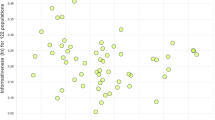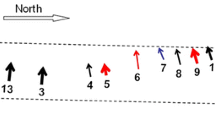Abstract
A genome-based investigation of three Muslim populations, the Salar, Bo'an, and Dongxiang, was conducted on 212 individuals (148 males, 64 females) co-resident in Jishisan County, a minority autonomous region located in the province of Gansu, PR China. The Salar are believed to be of Turkic origin, whereas the Bo'an and Dongxiang both speak Mongolian. Biparental dinucleotide markers on chromosomes 13 and 15 indicated elevated mean homozygosity in the Salar (0.32), Bo'an (0.32), and Dongxiang (0.27), equivalent to inbreeding coefficients (F is ) of 0.16; 0.12; 0.01, confirming varying levels of endogamous and consanguineous marriage in all three communities. Y-chromosome unique event polymorphisms (UEPs) showed that males in the three communities shared common ancient origins, with 80–90% of haplotypes in common. However, the high levels of community-specific Y-chromosome STR haplotypes strongly suggested the action(s) of founder effect, genetic drift and preferential consanguinity during more recent historical time. By comparison with the marked inter-community differentiation revealed by the Y-chromosome STRs (29.4%), the mtDNA data indicated similarity between the female lineages of each community with just 1.2% inter-community variation. The combined use of these different marker systems gives an in-depth historical perspective, and provides evidence of past inter-marriage between genetically diverse male founders of each community and Han Chinese females with subsequent community endogamy.



Similar content being viewed by others
References
Anderson S, Bankier AT, Barrell BG, de Bruijn MH, Coulson AR, Drouin J, Eperon IC, Nierlich DP, Roe BA, Sanger F, Schreier PH, Smith AJ, Staden R, Young IG (1981) Sequence and organization of the human mitochondrial genome. Nature 290:467–465
Bamshad MJ, Watkins WS, Dixon ME, Bhaskara BR, Naidu JM, Rasanayagam A, Hammer ME, Jorde LB (1998) Female gene flow stratifies Hindu castes. Nature 395:651–652
Bittles AH, Neel JV (1994) The costs of human inbreeding and their implications for variations at the DNA level. Nat Genet 8:117–121
Black ML, Wang W, Bittles AH (2001). A genome-based study of the Muslim Hui and the Han population of Liaoning province, PR China. Hum Biol 73:801–803
Budowle B, Wilson MP, DiZinno JA Stauffre C, Fasano MA, Holland MM, Monson KL (1999) Mitochondrial DNA regions HVI and HVII population data. Forensic Sci Int 103:23–25
Comas D, Calafell F, Mateu E, Perez-Lezaun A, Bosch E, Martinez-Arias R, Clarimon J, Facchini F, Fiori G, Luiselli D, Pettener D, Bertranpetit J (1998) Trading genes along the Silk Road: mtDNA sequences and origin of Central Asian populations. Am J Hum Genet 63:1824–1838
Chu JY, Huang W, Kuang SQ, Wang JM, Xu JJ, Chu ZT, Yang ZQ, Lin KQ, Li P, Wu M, Geng ZC, Tan CC, Du RF, Jin L (1998) Genetic relationship of populations in China. Proc Natl Acad Sci USA 95:11763–11768
de Knijff P, Kayser M, Caglia A, Corach D, Fretwell N, Gehrig C, Graziosi G, Heidorn F, Herrmann S, Herzog B, Hidding M, Honda K, Jobling M, Krawczak M, Leim K, Meuser S, Meyer E, Oesterreich W, Pandya A, Parson W, Penacino G, Perez-Lezaun A, Piccinini A, Prinz M, Roewer L, et al. (1997) Chromosome Y microsatellites: population genetic and evolutionary genetic and evolutionary aspects. Int J Legal Med 110:134–149
Ding YC, Wooding S, Harpending HC, Chi HC, Li HP, Fu YX, Pang JF, Yao YG, Yu JG, Moyzis R, Zhang Y (2000) Population structure and history in East Asia. Proc Natl Acad Sci USA 97:14003–14006
Du R, YipVF (1993) Ethnic groups in China. Science Press, Beijing and New York
Du R, Zhao ZL (1981) Percentage and types of consanguineous marriages of different nationalities and regions in China (in Chinese). Natl Med J China 61:723–728
Ebrey PB (1999) Cambridge illustrated history of China. Cambridge University Press, London
Excoffier L, Smouse PE, Quattro J (1992) Analysis of molecular variance inferred from metric distances among DNA haplotypes: Application to human mitochondrial DNA restriction data. Genetics 131:479–491
Felsenstein J (1985) Confidence limits on phylogenies: an approach using the bootstrap. Evolution 35:785–791
Family Planning Commission (1997) Chinese family planning yearbook 1997. Family Planning Commission, Beijing
Gladney DC (1996) Muslim Chinese: ethnic nationalism in the People's Republic. Harvard University Press, Cambridge, Massachusetts
Gladney DC (1998) Ethnic identity in China: the making of a Muslim minority nationality. Harcourt Brace, Fort Worth, Texas
Guo S, Thompson EA (1992) Performing the exact test of Hardy-Weinberg proportion for multiple alleles. Biometrics 48:361–372
Grant JC, Bittles AH (1997) The comparative role of consanguinity in infant and child mortality in Pakistan. Ann Hum Genet 61:143–149
Haff LA, Smirnov IP (1997) Single-nucleotide polymorphism identification assays using a thermostable DNA polymerase and delayed extraction MALDI-TOF mass spectrometry. Genome Res 7:378–388
Hammer MF, Karafet TM, Redd AJ, Jarjanazi, Sanatachiara-Benerecetti S, Soodyall H, Zegura SL (2001) Hierarchical patterns of global human Y-chromosome diversity. Mol Biol Evol 18:1189–1203
Heyer E, Puymirat J, Dielties P, Bakker E, de Knijff P (1997) Estimating Y chromosome specific microsatellite mutation frequency using deep rooting pedigrees. Hum Mol Genet 6:799–803
Hopgood R, Sullivan KM, Gill P (1992) Strategies for automated sequencing of Human mitochondrial DNA directly from PCR products. Biotechniques 13:82–92
Karafet T, Xu L, Du R, Wang W, Feng S, Wells RS, Redd AJ, Zegura SL, Hammer MF (2001) Paternal population history of East Asia: sources, patterns, and microevolutionary processes. Am J Hum Genet 69:615–628
Kumar S, Tamura K, Jakobsen IB, Nei M (2001) MEGA2: molecular evolutionary genetics analysis software. Bioinformatics 17:1244–1245
Leslie DD (1986) Islam in traditional China: a short history to 1800. Canberra College of Advanced Education, Canberra
Lipman JN (1997) Familiar strangers: a history of Muslims in Northwest China. Hong Kong University Press, Hong Kong
Ma P (1998) The taboo of the Hui woman to marry non-Hui men in the Hui people in Northwest China. The 14th International Congress of Anthropological and Ethnological Sciences, p 231
McElreavey K, Quintana-Murci L (2002) Understanding inherited disease through human migrations: a south-west Asian perspective. Community Genet 5:153–156
Minch E, Ruiz-Linares A, Goldstein D, Feldman M, Cavalli-Sforza LL (1997) Microsat v.1.5d: a computer program for calculating various statistics on microsatellite allele data (http://lotka.stanford.edu/microsat/microsat.html)
Nei M (1987) Molecular evolutionary genetics. Columbia University Press, New York
Quintana-Murci L, Krausz C, Zerjal T, Sayar SH, Hammer MF, Mehdi SQ, Ayub Q, Qamar R, Mohyuddin A, Radhakrishna U, Jobling MA, Tyler-Smith C, McElreavey K (2001) Y-chromosome lineages trace diffusion of people and languages in Southwestern Asia. Am J Hum Genet 68:537–542
Rahman YA (1997) Islam in China, http://www.erols.com/ameen/islchina
Rousset F (1995) Population genetics software for exact tests and ecumenicalism. J Hered 83:239
Rousset F, Raymond M (1995) Testing heterozygote excess and deficiency. Genetics 140:1413–1419
Seielstad MT, Minch E, Cavalli-Sforza LL (1998) Genetic evidence for a higher female migration rate in humans. Nat Genet 20:278–280
Stoneking M (1998) Women on the move. Nat Genet 20:219–220
Su B, Xiao J, Underhill P, Deka R, Zhang W, Akey J, Huang W, Shen D, Lu D, Luo J, Chu J, Tan J, Shen P, Davis R, Cavalli-Sforza L, Chakraborty R, Xiong M, Du R, Oefner P, Chen Z, Jin L (1999) Y chromosome evidence for a northward migration of modern humans in East Asia during the last ice age. Am J Hum Genet 65:1718–1724
Tamura K, Nei M (1993) Estimation of the number of nucleotide substitutions in the control region of mitochondrial DNA in humans and chimpanzees. Mol Biol Evol 10:512–526
Underhill P, Passerine G, In AA, Sheen P, Lah MM, Foley RA, Oefner PJ, Cavalli-Sforza LL (2001) The pylogeography of Y chromosome binary haplotypes and the origins of modern human populations. Ann Hum Genet 65:43–62
Wang W, Sullivan SG, Ahmed A, Chandler D, Zhivotovsky LA, Bittles AH (2000) A genome-based study of consanguinity in three co-resident endogamous Pakistan communities. Ann Hum Genet 64:41–49
Weir BS, Cockerham CC (1984) Estimating F-statistics for the analysis of population structure. Evolution 38:1358–1370
Wells RS, Yuldasheva N, Ruzibakiev R, Underhill PA, Evseeva I, Blue-Smith J, Jin L, Su B, Pitchappan R, Shanmugalakshmi S, Balakrishnan K, Read M, Pearson NM, Zerjal T, Webster MT, Zholoshvili I, Jamarjashvili E, Gambarov S, Nikbin B, Dostiev A, Aknazarov O, Zalloua P, Tsoy I, Kitaev M, Mirrakhimov M, Chariev A, Bodmer WF (2001) The Eurasian heartland: a continental perspective on Y-chromosome diversity. Proc Natl Acad Sci USA 98:10244–10249
Wong HM, Dajani AA (1988) Islamic frontiers in China. Scorpion, London
Acknowledgements
The cooperation of the Salar, Bo'an, Dongxiang communities is acknowledged with gratitude. Assistance in sample collection was provided by the Institute of Genetics, Chinese Academy of Sciences. Thanks go to Miss S. G. Sullivan for her technical support in the genotyping work. Financial support was provided by an Australian Research Council Small Grant (number A350 352).
Author information
Authors and Affiliations
Corresponding author
Rights and permissions
About this article
Cite this article
Wang, W., Wise, C., Baric, T. et al. The origins and genetic structure of three co-resident Chinese Muslim populations: the Salar, Bo'an and Dongxiang. Hum Genet 113, 244–252 (2003). https://doi.org/10.1007/s00439-003-0948-y
Received:
Accepted:
Published:
Issue Date:
DOI: https://doi.org/10.1007/s00439-003-0948-y




